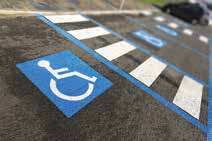Unsung Heroes

Beth Brainard
Ex Director of NPC
Several weeks ago, while riding my bike around town, I happened city staffers were wrapping up work on some handicapped only parking places. All four stood back with grins like Cheshire cats, admiring their work as several of us looked on, fascinated. They had created a bright blue parking spot clearly identified for special use only.
At that moment it suddenly occurred to me that these roadway markings do not just happen by magic. It also became apparent to me that these helpful road signs that we often take for granted require careful consideration, design, planning and application with the utmost attention to detail. It’s a passion. After this realization, I met with David Rivera of the City Streets and Traffic Division, and Alison Bickett, the City Traffic Engineer in the Streets and Storm Water Department.
I learned that prior to completing a road marking project there is quite a painstaking process. This process usually begins with the assessment of needs, often initiated with information from residents and various community organizations. Then there are visits by the staff to the location to evaluate and prioritize the project. The staff takes into consideration citywide needs to be sure of equal distribution of improvements.
Upon determination of project concept, measurements onsite are made, drawings are created, and the design is developed within the specifications of the Manual Uniform Traffic Control Devices guidelines, which are updated annually and incorporated into state standards.
 At this point, the final design is established, supplies are ordered, and a project date is set. Once new asphalt has been applied [usually after removal of the old surface] an outline of the design is spray painted on the surface until the new asphalt has cured. After curing, the crew of unsung heroes go to work:
At this point, the final design is established, supplies are ordered, and a project date is set. Once new asphalt has been applied [usually after removal of the old surface] an outline of the design is spray painted on the surface until the new asphalt has cured. After curing, the crew of unsung heroes go to work:
Courtney Conway, Richard Clark, Harold Fernandez and David Rivera carefully and painstakingly apply thermoplastic markings and emblems. This material lasts much longer than the painted road markings. When possible, these projects are undertaken during the off season summer months. Obviously, this is hard work during the hot season, but it is more convenient for residents.
This is the general process used for all of our roadway markings: center lines, automobile lanes, turning lanes,
cross walks and bike lanes. The markings contribute to our safety and ease of travel. Our unsung heroes take
pride in their work and I think the next time we pass a work in progress we should simply say “Thank You!”
Beth Brainard is the executive director of Naples Pathways Coalition (NPC), a nonprofit organization that works to create safe, bikeable, walkable communities in Collier County. For more information or to join, visit the NPC web site at www.naplespathways.org or contact Beth directly at bethbrainard@naplespathways.org



Leave a Reply
Want to join the discussion?Feel free to contribute!